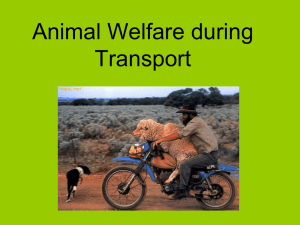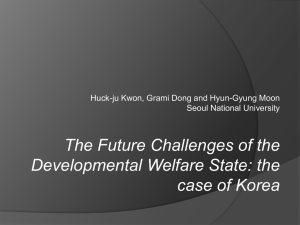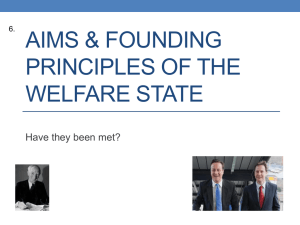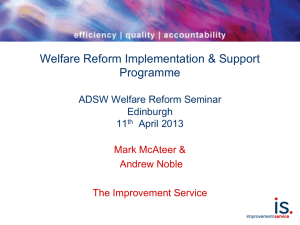Presentation
advertisement
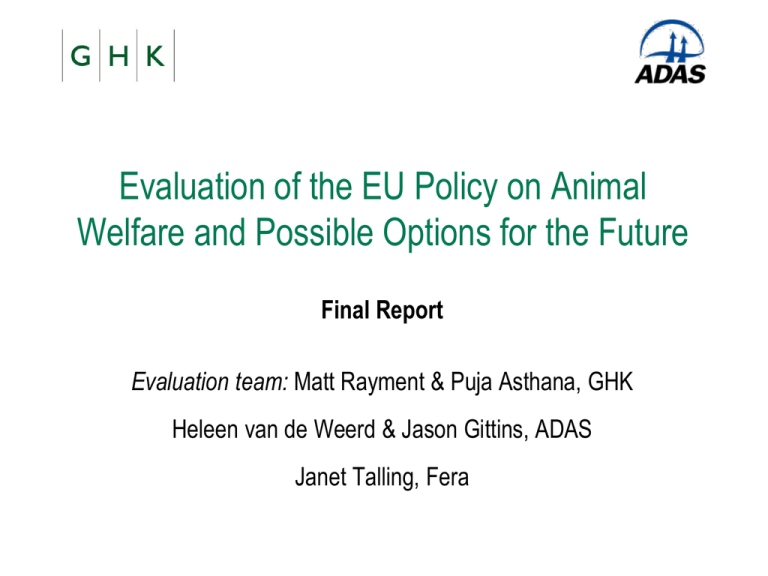
Evaluation of the EU Policy on Animal Welfare and Possible Options for the Future Final Report Evaluation team: Matt Rayment & Puja Asthana, GHK Heleen van de Weerd & Jason Gittins, ADAS Janet Talling, Fera Methods Online consultation – 9,086 responses Stakeholder interviews – 89 interviews with 196 individuals National missions – 12 Member States Literature and data review Answers to 11 evaluation questions Q1: To what extent has EU animal welfare legislation achieved its main objective - i.e. to improve the welfare conditions of animals within the EU? Legislation has improved welfare for those animals covered by targeted legislation – To be effective it needs detailed requirements, covering all aspects of welfare – Zoo animal legislation aims at biodiversity conservation and does not specifically refer to animal welfare There is potential to achieve much higher standards by strengthening the enforcement of current EU legislation By extending the scope of EU welfare legislation, several other groups of animals could benefit from higher welfare standards Q1: Possible options for the future Increasing levels of enforcement of existing legislation Considering extending the scope of EU welfare legislation to include large groups of animals for which welfare concerns exist Exploring non-legislative routes for achieving improved welfare conditions Stimulating further development of the Welfare Quality® project welfare assessment protocols (for enforcement) Enhancing the effectiveness of zoo animal legislation through better enforcement and by providing more detailed requirements for the needs of the animals under its scope Developing an inspection body to support the enforcement of the revised Experimental Animals Directive, and examining whether the FVO should take up this role Q2: To what extent has EU legislation on the protection of animals ensured proper functioning of the single market for the activities concerned? EU animal welfare legislation has contributed to, but not fully ensured, the proper functioning of the internal market Harmonisation is important in order to avoid competitive distortions within the internal market Specific EU animal welfare legislation has progressed the harmonisation of animal welfare standards across the EU Much greater variations in standards exist for those animals outside the scope of current EU legislation, such as dairy cows and pets Factors affecting harmonisation are: a lack of clarity; variations in enforcement; and standards that go beyond EU law Q2: Possible options for the future Enhancing the enforcement of existing legislation Clarification of aspects of legislation which have been interpreted differently between Member States Considering introducing EU welfare legislation for dairy cows and pets in order to achieve harmonisation of Member State legislation and to address the range of welfare issues Enhancing communication amongst Member States, and between Member States and the Commission on implementing and enforcing legislation, in order to promote shared understanding and encourage harmonisation Q3: To what extent has EU funding for research & scientific advice on animal welfare contributed to science based EU initiatives in the field of legislation, communication and for international initiatives? About €15 million of EU funding was allocated to scientific research on animal welfare in each year of the evaluation period In general, research funding reflects the main priorities of EU animal welfare legislation (farm animals and facilitating the replacement of in vivo animal testing) Information from EU research projects is linked with EU policy, primarily via EFSA activities There is less evidence of research informing communication actions and international activities There are concerns that the FP7 Ethics Review process does not meet its objectives Q3: Possible options for the future Allocating more EU research funding to the refinement of animal experiments and to zoo animal welfare, as these subjects have so far received little attention Evaluating the effectiveness of the FP7 ethics procedures Emphasising the importance of EFSA scientific opinion in the development of policy and legislation as well as raising welfare standards Facilitating improved coordination of animal welfare research between Member States. A European Reference Centre (or network of centres) could play a role in this Ensuring that EFSA opinions continue to cover the whole scope of the animal welfare policy area, also including non-food-producing animals Q4: To what extent have EU actions of communication to stakeholders and the public contributed to raise their awareness and responsibility towards animal welfare? EU has supported events, online resources & policy consultations Insufficient evidence to determine the impact on stakeholders and public awareness and responsibility towards animal welfare Size of potential task faced by the Commission and its partners in relation to animal welfare communications is large: – Large and varied audiences; limited EU resources relative to the scale of task; variety of organisations involved in animal welfare communications A communications strategy would help focus activity to maximise impact; stronger monitoring would help assess impact Q4: Possible options for the future Developing an animal welfare communication strategy: – Definition of problem to be addressed; identify audiences and means by which EU supported communication activities can influence them; objectives and key messages of communications activity; Commission and partners’ roles and responsibilities; implementation plan – Focus on communications directly linked to EU policy Stronger and consistent monitoring and evaluation of communication activity Continuing work to examine options for development of animal welfare labelling and consumer information in the EU Regular publications to raise profile of animal welfare at EU level Q5: To what extent have EU international initiatives contributed to raising awareness and creating a shared understanding on animal welfare issues and standards at world level? EU international initiatives have been widely welcomed by third countries and are recognised as having raised the profile and awareness of animal welfare in a global context Trade agreements, support to organisations, standards-setting and science / technology transfer have all contributed There is still much to be achieved, and there is widespread support from stakeholders that this should continue to be a priority area for the EU Q6: To what extent have EU international initiatives contributed to establishing equivalent market conditions between EU businesses and businesses from third countries exporting to the EU? Significant differences remain between animal welfare legislation and voluntary standards in the EU and third countries Production costs are generally higher in the EU than elsewhere, mainly because of high land, feed and labour costs EU has influenced the OIE to develop international principles and recommendations, also via bilateral agreements This is work in progress and implementation and enforcement of international standards remain challenges for the future Q5,6: Possible options for the future Continuing EU support to the inclusion of animal welfare in OIE and FAO initiatives and in bilateral agreements Paying attention to ways of encouraging and enforcing the adoption of animal welfare standards at international level, such as encouraging participation of third countries in international training initiatives Communicating the goals and achievements of international activities more widely within the EU and to other stakeholders Reviewing the EU’s international activities and evaluating outcomes periodically, to focus on the most successful strategies Q7: Are the present financial instruments and the financial resources at EU level adapted to the needs of the EUPAW? Would it be necessary to establish specific financial instruments and/or dedicated resources to EU initiatives related to animal welfare? Financial resources for the development and implementation of EUPAW are modest but increasing – – – Further growth will be needed as the policy develops further Could be benefit from more dedicated resources for animal welfare FVO would benefit from more resources for inspection efforts Substantial funding is provided to third parties through different EU schemes – priority is to maximise the benefits of these Member States devote substantial resources to research, and to implementation and enforcement, exceeding EU expenditure Q7: Possible options for the future Ensuring adequate growth in funding for the EUPAW over the next action plan period, in line with the growing needs of the policy Ensuring that the FVO has sufficient funding to ensure adequate levels of inspection and enforcement effort Examining the need for more dedicated budget lines dedicated to support key aspects of animal welfare policy Ensuring sufficient EU resources for meeting the requirements of the revised Experimental Animals Directive Emphasising the importance of CAP to animal welfare, as part of the current CAP reform debate Q8: To what extent does the EUPAW address the needs of stakeholders and the EU citizens? Which areas need changes concerning objectives, scope, management systems or processes? EU citizens and stakeholders have diverse needs and expectations – with varying emphasis on different aspects of EUPAW General public support for EU’s approach to improving farm and experimental animal welfare No compelling case for changing general direction of the policy Basic principles reaffirmed - policy should be clear, enforceable and based on sound science and economics Interests of different groups need to be balanced and taken into account as the policy develops Q8: Possible options for the future While current arrangements appear to work well, a more formal and structured approach to stakeholder engagement could be considered in future (as part of a wider communications strategy) Establishing working groups between Member States and the Commission for dialogue/co-ordination on legislation, research In consultation with stakeholder groups, assessing the need to develop new modes of engagement over time, such as: – stakeholder platforms – online fora – advisory committees. Q9: To what extent do the EUPAW intervention logic, objectives & activities support or conflict with those of other EU policies? Are they internally complementary, mutually supportive and consistent? Elements of the EUPAW are broadly internally consistent and coherent with other areas of EU policy No major areas of conflict, but some specific examples of tensions between the EUPAW and other policies Some trade-offs between animal welfare and other policy goals Examples of where different elements of the EUPAW (research, legislation, communication & international activities) are mutually supportive and support other EU policy areas Q9: Possible options for the future Consider addressing specific areas where there are apparent conflicts, such as between rules for animal transport and driver hours Q10: To what extent do animal welfare policies contribute to the economic sustainability of the sectors concerned (farming and experimental animals)? Widely accepted that animal welfare policies increase costs of businesses in the farming and experimental sectors – – Estimated additional annual costs of €2.8 billion for farm animals, €54 million for experimental animals ≈ 2% of overall output Higher standards have business benefits, though usually outweighed by costs Limited evidence of the economic impact of EU legislation on the sectors affected – – – Scale of impacts depends on economic factors in industries affected Little independent evidence that animal welfare policies have affected economic sustainability of the sectors concerned Trade liberalisation could increase impacts in future Q10: Possible options for the future Rural development programmes can support investment and aid adaptation to higher standards in the farming sector Designing legislation to manage adverse impacts, e.g. through phase in periods and flexible, outcome based standards Targeted R&D for economically sustainable standards Promoting development and harmonisation of labelling schemes Examining role of public procurement and corporate social responsibility in rewarding high standards Further independent research to enhance understanding of economic impacts, and particularly business benefits Q11: What costs are involved in the management of the EUPAW for the Member States' public administrations? On-farm inspections, central policy costs , transport inspections involve major costs in all MS – Regulation costs for experimental animals significant in some Member States generally unable to give costs of national administration of the EUPAW – best estimates have been made Estimates of annual costs for 27 Member States: – Central costs €13 million; farm inspections €53 million; transport inspections €14-15 million; slaughter inspections €24-25 million; experimental animals €0.5 million [total of €105 million] Data indicate large differences between Member States, due to level of inspections and other issues Q11: Possible options for the future Improving dialogue between the Commission and Member States in respect of data requirements, thus allowing exchange of information on the data supplied and resolving apparent anomalies This would also help to quantify the main areas of administration costs and identify opportunities for cost reductions

